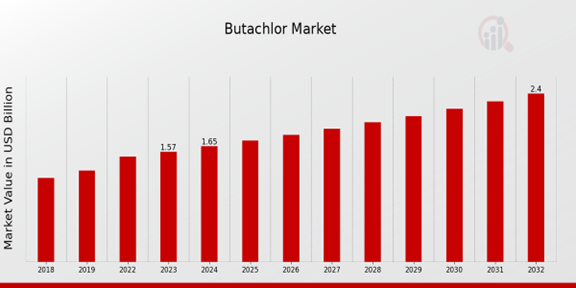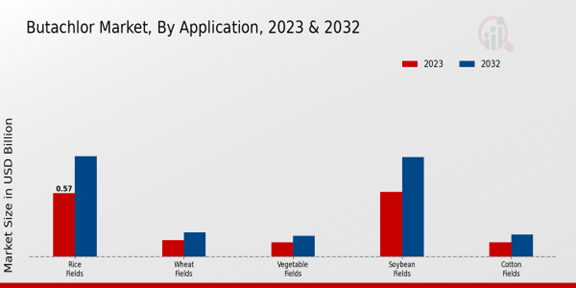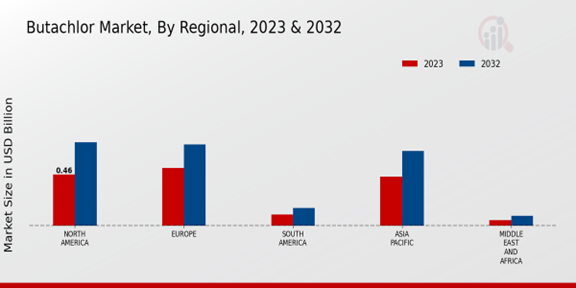Global Butachlor Market Overview
The Butachlor Market Size was estimated at 1.5 (USD Billion) in 2022. The Butachlor Industry is expected to grow from 1.57(USD Billion) in 2023 to 2.4 (USD Billion) by 2032. The Butachlor Market CAGR (growth rate) is expected to be around 4.83% during the forecast period (2024 - 2032).
Key Butachlor Market Trends Highlighted
Key market drivers for butachlor include increasing demand for rice, rising adoption of herbicide-resistant rice varieties, and government initiatives to promote sustainable agriculture. Opportunities for exploration and capture lie in the development of new formulations, combination products, and application technologies. Recent trends in the butachlor market reveal a shift towards eco-friendly alternatives, precision agriculture, and digital farming solutions.

Source: Primary Research, Secondary Research, MRFR Database and Analyst Review
Butachlor Market Drivers
Increasing Adoption of Precision Farming Techniques
The application of advanced technologies to make crop production more precise and reduce negative environmental impact is associated with precision farming. In this context, butachlor is utilized to control weeds as an important part of precision farming systems to achieve better produce yields. In the future, the broader application of precision farming is linked to the increase in the demand for butachlor. At the same time, it is important to note that precision farming can be defined as an appropriate approach to using butachlor because the use of butachlor can be more efficient with the help of advanced technologies so that product application will be less costly, and investments in this solution will be far more profitable.Key factors associated with the increased application of precision farming: Climbing labor costs, Increasing levels of environmental concerns and associated regulatory pressure, Acceleration of the demand for food and Technological progress. The connection between precision farming technologies and the butachlor market: the greater use of precision farming is expected to be beneficial for the butachlor market because, with higher levels of its application, the demand for butachlor will also climb due to its role in the new framework of the farming technique.
Rising Demand for Food
The population is growing, and this is putting a strain on the world's food supply. Butachlor is an important herbicide that helps farmers control weeds and improve crop yields. The rising demand for food is expected to drive the demand for butachlor in the coming years. Key Factors Driving the Rising Demand for Food Population Growth Increasing Urbanization Changing dietary habitsThe Impact of Rising Demand for Food on the Butachlor Market The rising demand for food is expected to have a positive impact on the butachlor market.As the demand for food increases, farmers will need to use more butachlor to control weeds and improve crop yields. This is likely to lead to an increase in the demand for butachlor in the coming years.
Growing Adoption of Sustainable Farming Practices
The popularity of sustainable farming practices has been increasing, as many farmers are seeking ways to reduce the environmental impact of their farming. Butachlor is a relatively safe herbicide that has a low environmental impact. Therefore, the growing adoption of sustainable farming practices is expected to drive the demand for butachlor in the near future. Key Factors Driving the Growing Adoption of Sustainable Farming Practices Increasing consumer demand for sustainably produced food Government policies that promote sustainable farming Growing awareness of the environmental impact of agriculture How Growing Adoption of Sustainable Farming Practices Will Impact the Butachlor Market The growing adoption of sustainable farming practices is expected to have a positive impact on the butachlor market.As farmers continue to adopt sustainable farming practices, the demand for butachlor is likely to grow. This is because butachlor is a relatively safe herbicide that has a low environmental impact.
Butachlor Market Segment Insights
Butachlor Market Application Insights
Among the application areas of the Butachlor Market, the application segment is highly significant, prominently influencing market dynamics and growth trajectories. Some important application areas of butachlor are highlighted below: Rice Fields: Butachlor is extensively used in rice fields to control a broad spectrum of grassy weeds like barnyard grass, jungle rice and sprangletop. The application market in the rice fields segment is expected to register steady growth with the growing demand for rice, both as a staple food crop and as a cash crop.Apart from that, the need to increase crop yield and enhance the quality of rice produced will also power market growth. Wheat Fields: Butachlor is also applied in wheat fields to control grassy weeds like wild oats, annual ryegrass, downy brome and many more. Market growth in the wheat fields segment is estimated to take place at a CAGR of over 4% as data. As more farmers increasingly adopt precision farming techniques in order to ensure soil health and high crop yield and focus on sustainable weed control methods, the growth of the field segment is expected to be promoted.Vegetable Fields: Butachlor is used in vegetable fields to control weeds in crops like soybeans, cotton and peanuts. The market is thought to witness consistent growth, powered by the increasing demand for vegetables and the need to safeguard crops from the menace of weeds. Soybean Fields: Butachlor is a critical application to control annual grasses and broadleaf weeds in soybean fields. The growth of the market in the soybean fields segment is expected to be highly significant in the years ahead, fueled by the simultaneously growing soybean production and the national and regional-level stress on integrated weed management.Cotton Fields: Butachlor is extensively applied in cotton fields to control weeds and others that decimate cotton plants both by competing for all the nutrients and moisture and by blocking solar energy. The growth of the market in the cotton fields segment is estimated to be moderate with the growing cultivation of cotton and the need to protect plants and increase crop yield and quality. Overall, the application segment of the Butachlor Market is expected to register steady growth driven by trends such as increasing demand for all types of agricultural products, the adoption of sustainable farming trends and the drive to achieve higher crop yield and better quality.

Source: Primary Research, Secondary Research, MRFR Database and Analyst Review
Butachlor Market Formulation Insights
The Butachlor Market growth and segmentation are significantly affected by the formulation segment. In 2023, the liquid formulation held the leading market position, generating more than 45% of Butachlor Market revenue. The most significant factors contributing to the liquid formulation’s popularity are its ease of application, uniform distribution, and efficiency against different types of weeds. Granular formulations constitute a notable part of the market share as they are released slowly and can be applied in various soil conditions.Emulsifiable concentrates are becoming more popular due to their concentration in pesticide form, which can be easily mixed and used. The WP and SC formulations also can be observed on the market and used when required. Being relatively new, the Butachlor Market continues to increase, thus leading to regular changes and improvements in the formulation segment. Manufacturers work on adding new features that could enhance the effectiveness and mitigate the environmental impact, as well as meet the needs that are subject to change.
Butachlor Market Purity Insights
The purity of Butachlor plays a crucial role in determining its quality and effectiveness. The Butachlor Market can be segmented into three main purity grades: Below 90%, 90-95% and Above 95%. Below 90%: This segment holds a substantial share of the market due to its cost-effectiveness. It is commonly used in applications where high purity is not a critical requirement, such as weed control in agricultural fields. 90-95%: This segment is experiencing steady growth as it offers a balance between cost and purity. It is preferred by manufacturers who require higher purity levels for specific applications, such as in the production of herbicides and pesticides.Above 95%: This segment represents the highest purity grade and commands a premium price. It is used in specialized applications where exceptional purity is paramount, such as in the pharmaceutical industry and laboratory analysis. The demand for this segment is expected to grow significantly in the coming years, driven by the increasing need for high-quality Butachlor in various industries.
Butachlor Market Crop Type Insights
The Butachlor Market is segmented by Crop Type into Cereals, Legumes, Oilseeds, Vegetables, and Cotton. Cereals hold the largest share of the market, accounting for over 40% of the Butachlor Market revenue in 2023. The growing demand for cereals such as rice, wheat and corn is driving the growth of the Butachlor Market in this segment. Legumes, Oilseeds, and Vegetables are also significant segments, with a combined market share of over 35%. Butachlor is widely used in these crops to control both pre- and post-emergence weeds, ensuring higher crop yield and quality.The Cotton segment is expected to witness steady growth over the forecast period, owing to the increasing cotton production in developing countries. The Butachlor Market is highly competitive, with several key players operating in the market.
Butachlor Market Regional Insights
The Butachlor Market segmentation by region is a key aspect of understanding the industry's geographical distribution and growth patterns. The market is segmented into North America, Europe, APAC, South America and MEA. North America held the largest share of the Butachlor Market revenue in 2023, owing to the extensive use of herbicides in agricultural practices and the presence of major agrochemical companies in the region. The APAC region is expected to witness significant growth in the coming years due to the increasing demand for food production and the adoption of modern farming techniques.Europe is also a major market for butachlor, with a demand driven by the need for weed control in agricultural areas. South America and MEA are emerging markets for butachlor, with the potential for growth as agricultural practices evolve and the demand for food production increases.

Source: Primary Research, Secondary Research, MRFR Database and Analyst Review
Butachlor Market Key Players And Competitive Insights
The Butachlor Market industry is intensely competitive, with several major players competing for market share. Leading Butachlor Market players are continuously innovating and developing new products to meet the changing needs of customers. The competitive environment is marked by mergers and acquisitions, as well as strategic partnerships and alliances. Key players in the Butachlor Market include BASF, Bayer, FMC Corporation, Syngenta and Adama. These companies have a strong presence and offer a wide range of products and services in the Butachlor Market.BASF is a leading chemical company that provides a broad portfolio of products and services in the. The company supplies herbicides, fungicides, insecticides and seed treatments in the Butachlor Market. BASF is a major player in the Asia-Pacific market, and it is one of the largest suppliers in China. The company is also a leader in the field of new Butachlor Market technologies and holds a number of patents in the field.Syngenta is another major player in the Butachlor Market. The company supplies a wide range of products and services, including herbicides, fungicides, insecticides and seed treatments. Syngenta has a strong presence and is one of the largest suppliers in the Americas. The company is also a leader in the field of new Butachlor Market technologies and holds a number of patents in the field.
Key Companies in the Butachlor Market Include
- Jiangsu Good HarvestWeifang
- Adama Agricultural Solutions
- Jiangsu Huifeng Bioagriculture
- Jiangsu Huifeng Pesticide Fine Chemical
- Nantong Excel Industries
- Jiangsu Yangnong Chemical Group
- Shenzhen Yuanquan Chemical
- Dow AgroSciences
- Liaoning Sinochem
- Shandong Dacheng Agrochemical
- Nantong Jiangshan Agrochemical Chemicals
- Hebei Veyong BioTech Co., Ltd.
- Hubei Sanonda Co., Ltd
- Fujian Sannong
- Gharda Chemicals
Butachlor Market Industry Developments
The Butachlor market is projected to reach a valuation of USD 2.4 billion by 2032, expanding at a CAGR of 4.83% from 2024 to 2032. The increasing demand for rice and the growing adoption of sustainable agricultural practices are major factors driving the market growth. Additionally, government initiatives to promote Butachlor as a low-cost and effective herbicide are further contributing to the market expansion. Recent news developments include the launch of new Butachlor formulations with improved efficacy and reduced environmental impact, as well as strategic partnerships between key players to enhance market reach.
Butachlor Market Segmentation Insights
Butachlor Market Application Outlook
- Rice Fields
- Wheat Fields
- Vegetable Fields
- Soybean Fields
- Cotton Fields
Butachlor Market Formulation Outlook
- Liquid
- Granular
- Emulsifiable Concentrate
- Wettable Powder
- Suspension Concentrate
Butachlor Market Purity Outlook
- Below 90%
- 90-95%
- Above 95%
Butachlor Market Crop Type Outlook
- Cereals
- Legumes
- Oilseeds
- Vegetables
- Cotton
Butachlor Market Regional Outlook
- North America
- Europe
- South America
- Asia Pacific
- Middle East and Africa
| Report Attribute/Metric |
Details |
| Market Size 2022 |
1.5(USD Billion) |
| Market Size 2023 |
1.57(USD Billion) |
| Market Size 2032 |
2.4(USD Billion) |
| Compound Annual Growth Rate (CAGR) |
4.83% (2024 - 2032) |
| Report Coverage |
Revenue Forecast, Competitive Landscape, Growth Factors, and Trends |
| Base Year |
2023 |
| Market Forecast Period |
2024 - 2032 |
| Historical Data |
2019 - 2023 |
| Market Forecast Units |
USD Billion |
| Key Companies Profiled |
Jiangsu Good HarvestWeifang, Adama Agricultural Solutions, Jiangsu Huifeng Bioagriculture, Jiangsu Huifeng Pesticide Fine Chemical, Nantong Excel Industries, Jiangsu Yangnong Chemical Group, Shenzhen Yuanquan Chemical, Dow AgroSciences, Liaoning Sinochem, Shandong Dacheng Agrochemical, Nantong Jiangshan Agrochemical Chemicals, Hebei Veyong BioTech Co., Ltd., Hubei Sanonda Co., Ltd, Fujian Sannong, Gharda Chemicals |
| Segments Covered |
Application, Formulation, Purity, Crop Type, Regional |
| Key Market Opportunities |
Growing demand for herbicide-resistant crops Rapidly increasing population and need for enhanced food production Technological advancements in herbicide application Expansion of agricultural land in developing countries Government regulations and incentives promoting sustainable farming practices. |
| Key Market Dynamics |
Rising demand Technological advancements Stringent regulations Increasing awareness Growing adoption of sustainable practices |
| Countries Covered |
North America, Europe, APAC, South America, MEA |
Frequently Asked Questions (FAQ) :
The Butachlor Market is anticipated to reach a valuation of approximately 1.57 Billion USD in 2023.
The Butachlor Market is estimated to exhibit a CAGR of 4.83% over the forecast period of 2024 to 2032.
By 2032, the Butachlor Market is projected to reach a valuation of around 2.4 Billion USD.
The Asia-Pacific region is expected to dominate the Butachlor Market throughout the forecast period.
Butachlor is primarily utilized as a selective herbicide for controlling weeds in rice cultivation.
BASF, Bayer, Syngenta, and FMC Corporation are among the prominent players in the Butachlor Market.
The increasing demand for rice and the need for effective weed control solutions are key factors driving market growth.
Stringent regulations regarding pesticide usage and the emergence of herbicide-resistant weeds pose challenges to market growth.
Expansion into new markets and the development of innovative formulations present opportunities for market growth.
Precision farming practices and the adoption of sustainable agriculture methods are key trends influencing the market.





























